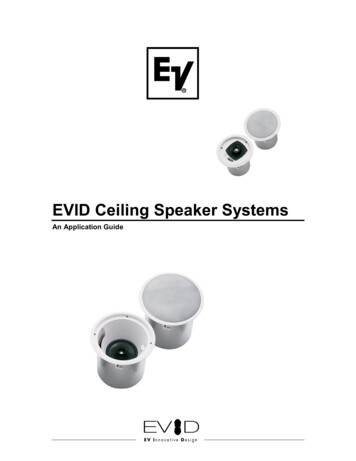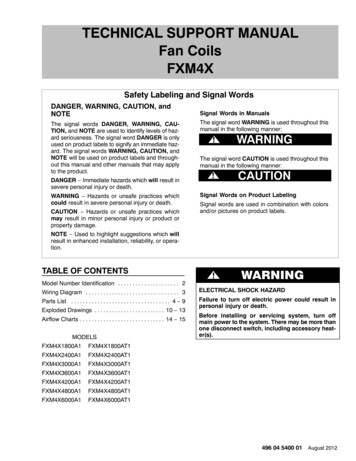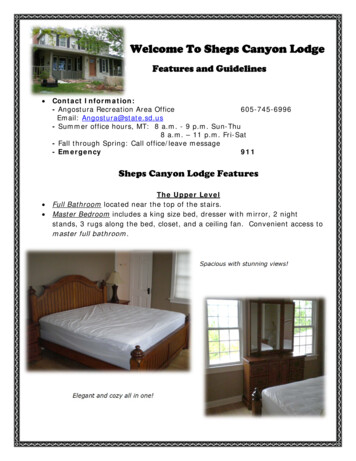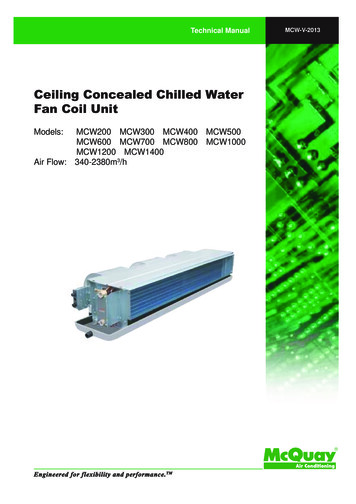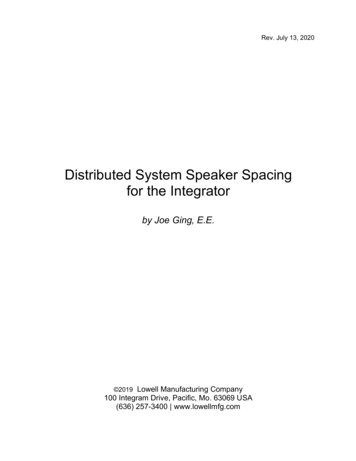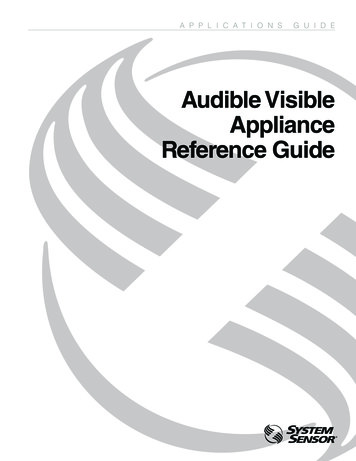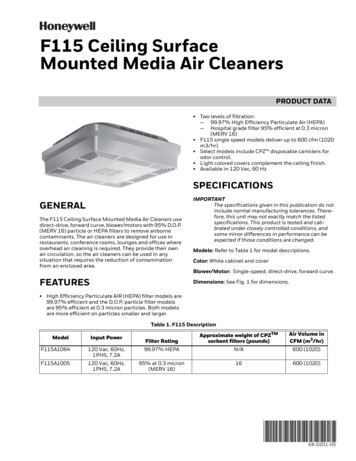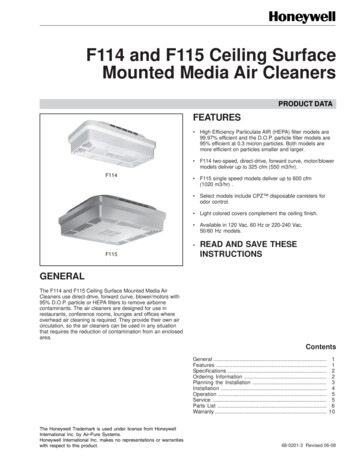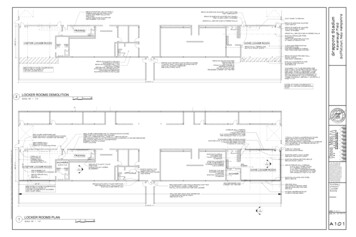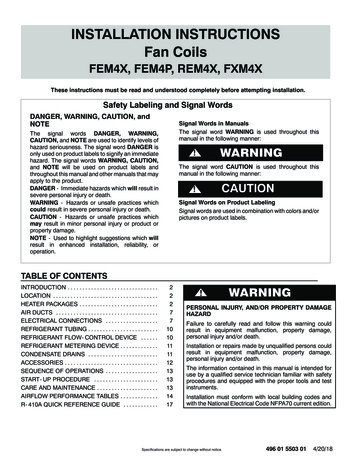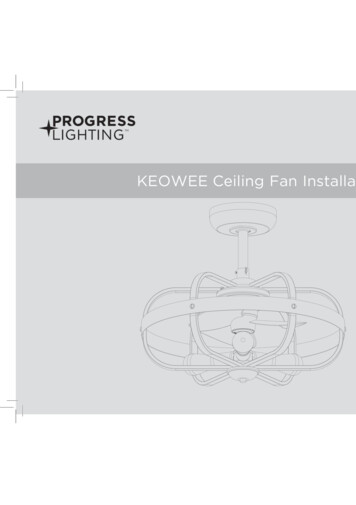
Transcription
KEOWEE Ceiling Fan Installat
Limited Lifetime WarrantyProgress Lighting fan motors are warranted to the original purchaser to be free of electrical and/or mechanical defects for solong as the original purchaser owns the fan. Pull chain switches, reverse switches, capacitors and metal finishes are warranted tobe free from defects in materials or workmanship for a period of 1 year from the date of purchase. Warping of wooden or plasticblades is not covered by this warranty nor is corrosion and/or deterioration of any finishes for fans installed within ten miles ofany sea coast. Extended warranties for ENERGY STAR qualified products may apply.Progress Lighting ceiling fans with built-in LED light sources, when properly installed and under normal conditions of use, arewarranted to be free from defects in material and workmanship which cause the light sources to fail to operate in accordancewith the specifications for (i) five (5) years from the date of purchase on the LED Light modules and electrical components forfans used in single family residences, and (ii) three (3) years from the date of purchase on the LED Light modules and electricalcomponents for fans used in multi-family or commercial applications. LED bulbs supplied by Progress Lighting carry nowarranty other than manufacturer’s warranty. Non-LED bulbs carry no warranty.With proof of purchase, the original purchaser may return the defective fan to the place of purchase during the first 30 days forreplacement. After 30 days, the original purchaser MUST contact Progress Lighting at (864) 678-1000 for repair or replacementwhich shall be determined in Progress Lighting’s sole discretion and shall be purchaser’s sole and exclusive remedy.Labor and Shipping Excluded. This warranty does not cover any costs or fees associated with the labor (including, but notlimited to, electrician’s fees) required to install, remove, or replace a fan or any fan parts.This warranty shall not apply to any loss or damage resulting from (i) normal wear and tear or alteration, misuse, abuse orneglect, or (ii) improper installation, operation, repair or maintenance by original purchaser or a third party, including withoutlimitation improper voltage supply or power surge, use of improper parts or accessories, unauthorized repair (made orattempted) or failure to provide maintenance to the fan.THE FOREGOING WARRANTIES STATE PROGRESS LIGHTING’S ENTIRE WARRANTY OBLIGATION ANDORIGINAL PURCHASER’S SOLE AND EXCLUSIVE REMEDY RELATED TO SUCH PRODUCTS. PROGRESSLIGHTING IS NOT RESPONSIBLE FOR DAMAGES (INCLUDING INDIRECT, SPECIAL, INCIDENTIAL ORCONSEQUENTIAL), DUE TO PRODUCT FAILURE, WHETHER ARISING OUT OF BREACH OF WARRANTY,BREACH OF CONTRACT, OR OTHERWISE. THIS WARRANTY IS GIVEN IN LIEU OF ALL OTHER WARRANTIES,WHETHER EXPRESSED OR IMPLIED, INCLUDING THOSE OF MERCHANTABILITY, FITNESS FOR A PARTICULARPURPOSE OR NONINFRINGEMENT.Some states do not allow limitations on how long an implied warranty lasts or the exclusion or limitations of incidental orconsequential damages, so the above limitations and exclusions may not apply to you. This warranty gives you specific rightsand you may have other rights which vary from state to state.D ateSto r eModSer iaVendUPC
Safety Rules.Unpacking Your Fan .Installing Your Fan .Operating Your Transmitter .Care of Your Fan .Troubleshooting .Specifications.Ta ble o f
1. To reduce the risk of electric shock, insure electricity has been turned offat the circuit breaker or fuse box before beginning.8.To avoid personal injury or damagecautious when working around or clea2. All wiring must be in accordance with the National Electrical Code andlocal electrical codes. Electrical installation should be performed by aqualified licensed electrician.9.Do not use water or detergents whendry dust cloth or lightly dampenedcleaning.3. WARNING: To reduce the risk of electrical shock and fire, do not usethis fan with any solid-state fan speed control device.10. After making electrical connectionsturned upward and pushed carefullyshould be spread apart with theequipment-grounding conductor on on4. WARNING: To reduce the risk of fire, electric shock, or personal injury,mount to outlet box marked "Acceptable for Fan Support of 15.9 kg (35 lbs.)Or Less" and use mounting screws provided with the outlet box. Most outletboxes commonly used for the support of light fixtures are not acceptable forfan support and may need to be replaced. Due to the complexity of theinstallation of this fan, a qualified licensed electrician is stronglyrecommended.WARNINGTO REDUCE THE RISK OF FIRE, ELECTRIC SHOCK OR PERSONALINJURY, MOUNT FAN TO OUTLET BOX MARKED ACCEPTABLE FORFAN SUPPORT.11. Electrical diagrams are for reference owith the fan must be cUL Listed andmodel fan you are installing. SwitcSwitches. Refer to the Instructions pacWARNINGTO REDUCE THE RISK OF PERSONALBLADE ARMS (ALSO REFERRED TOASSEMBLY OR AFTER INSTALLATION.THE PATH OF THE5. The outlet box and support structure must be securely mounted andcapable of reliably supporting a minimum of 35 lbs (15.9 kg) or less.Use only cUL-listed outlet boxes marked FOR FAN SUPPORT.6. The fan must be mounted with a minimum of 7 ft (2.1m) clearance fromthe bottom of the fan guard to the floor.7. Avoid placing objects in the path of the blades.1. S afety Ru lesNOTEREAD AND SAVE ALL IN
ON DIP32MEDHI1 2 3 415LOWOFF647Unpack your fan and check the contents. You should have the following items:1. Canopy assembly2. Ball/downrod assembly3. Fixture assembly4. LED bulbs (3)5. Receiver6. Transmitter7. 9V battery8. Loose para. Mountingb. #8 X 1-1/c. #8-32 Scrd. Flat washe. Spring waf. Lock washUnpacking Y
Tools RequiredAngled ceilingmaximum18.5 anglePhillips screw driver, straight slot screw driver,adjustable wrench, step ladder, and wire cutters.Mounting OptionsRecessedoutlet boxIf there isn't an existing cUL listed mountingbox, then read the following instructions.Disconnect the power by removing fuses orturning off circuit breakers.Secure the outlet box directly to the buildingstructure. Use appropriate fasteners and buildingmaterials. The outlet box and its support must beable to fully support the moving weight of thefan (at least 35 lbs). Do not use plastic outletboxes.Outlet boxFigure 1Figure 3Note: You mamaintain propersteep, sloped ceilWARNINGTO REDUCE THE RISK OF FIRE, ELECTRICSHOCK, OR OTHER PERSONAL INJURY,MOUNT FAN ONLY TO AN OUTLET BOXMARKED ACCEPTABLE FOR FAN SUPPORTAND USE THE MOUNTING SCREWSPROVIDED WITH THE OUTLET BOX. OUTLETBOXES COMMONLY USED FOR THESUPPORT OF LIGHTING FIXTURES MAY NOTBE ACCEPTABLE FOR FAN SUPPORT ANDMAY NEED TO BE REPLACED. CONSULT AQUALIFIED ELECTRICIAN IF IN DOUBT.Outlet boxFigure 23. Installing Your FanFigure 4To hang your ffixture but noinstallation han(available at you
Hanging the FanREMEMBER to turn off the power. Follow thesteps below to hang your fan properly:Step 1. Insert the end of downrod (B) throughthe connector (PP),align the two holes in thedownrod (B) and the connector (PP).(Fig.5)Step 2. Insert a plug pin (GG) through the twoholes in the downrod (B) and the connector (PP).(Fig.5)Step 3. Insert the R-shaped pin (HH) though thehole near the end of the plug pin (GG) until itsnaps into its locked position. (Fig.5)Step 4. Install the screw (FF) to the connector(PP), and make sure it’s tighten. (Fig.5)Step 5. Insert the canopy (C) and metal cover(D) through the downrod (B). (Fig.6)Step 8. Installoutlet box by umounting screStep 6. Insert the hanger ball (J) through thedownrod (B), and then Insert a plug pin (L)through the hole in the downrod (B). (Fig.6)Step 9. Put theside of the ceilinsert the hangceiling mountiStep 7. Iinsert the plug pin to the slot cut off inthe hanger ball (J) until it snaps into its lockedposition. (Fig.6)
Make the ElectricConnectionsWARNING: To avoid possible electricalshock, be sure electricity is turned off at themain fuse box before wiring.CODE SWITCH: Codes are set by pushing dipswitches up or down. It is imperative that thecode used for both transmitter and receiver isexactly the same, otherwise remote controllerwill not work. Please note the code switch willenable you to operate a second remotecontroller independently. For example, if youhave two ceiling fans with 2 remote controlunits, set 2 different codes for each set oftransmitter/receivers. This means you canoperate each ceiling fan independently.Your remote control is ready for use afterbattery installation. (Fig.8)Step 1. Fan motor to Receiver ElectricalConnections: Connect the Black wire from thefan motor to Black wire marked "to fan motorL". Connect the White wire from the fan motorto the White wire marked " to fan motor N "from the receiver. Connect the blue wire fromthe light to the blue wire from the Receiver.Secure wire connections with the plastic wirenuts provided. (Fig. 9)Step 2. Receiver to House Supply WiresElectrical Connections: Connect the black (hot)wire from the ceiling to the black wiremarked "AC in L" from the receiver.Connect the white (neutral) wire from theceiling to the white wire marked "AC in N"from the Receiver. Secure the wire connectionswith the plastic wire nuts provided. (Fig. 9)Step 3. If your outlet box has a ground wire(green or bare copper) connect it to the fanground wires; otherwise connect the hangingbracket ground wSecure the wire coprovided. After cothem apart so thaton one side of thewires are on the owire connections9)Outlet boxBlack (hot)Black ("AC IN L")ReceiverBlue(to light)White("to Fan motor N")Black("to Fan motor L")Black(for Fan motor)White(neutral)Blue(for light)Fan motor
5.Installing metStep 4. Once the connection has been made,the receiver inserts into the drop rod hangingbracket. The canopy comes up to cover thereceiver and bracket. (Fig. 10)Step 1. Insert the fshaft (U), install loafter the blade ass12)Step 2. Screw lighsockets. (Fig. 12)Figure 12FInstalling the canopy:Step 1. Align the locking slots of the canopy(C) with the two screws (FF) in the mountingbracket (A). Push up to engage the slots and tolock in place. (Fig. 11)Step 2. Rotate the metal cover (D) clockwiseto lock in the bottom of the canopy. (Fig. 11)MQ
6.
The Reverse shousing. Slide tweather operatiofor cool weatherFUNCTIONS OF TRANSMITTER:OFFHI: Turn off the ceiling fan.NOTE: Wait for fof the slide switch: Turn on the fan at high speed.MED: Turn on the fan at medium speed.LOW: Turn on the fan at low speed.LIGHT : ON/OFF- Press and releaseimmediately to turn on or off the light.Speed settings fofactors such as thefans, etc.Installation of TransmitterWall Mount Holder with twoscrews.DIMMER(If any)- Press and hold on to dimmeror brighten the light.Warm weathercreates a coolingallows you to sesetting without affeCool weather - (warm air off theThis allows you tsetting without affeR7. Operating Your Transmitter
Disassembling Your FanThis fan comes with a pre-assembled the blade and frontguard for your easy installation. Check that all screws aretight and securely in place.Use a lint free lightly damp cloth or duster to remove dustfrom the blades.Figure 14Figure 15
Here are some suggestions to help you maintain your 3. You can apply a light coat of furniture polish to thefanwood blades for additional protection and enhancedbeauty. Cover small scratches with a light application1. Because of the fan's natural movement, some of shoe polish.connections may become loose. Check the supportconnections, brackets, and blade attachments 4. There is no need to oil your fan. The motor hastwice a year. Make sure they are secure. (It is not permanently lubricated bearings.necessary to remove fan from ceiling.)IMPORTANT2. Clean your fan periodically to help maintain its newMAKE SURE THE POWER IS OFF AT THEELECTRICAL PANEL BOX BEFORE YOUappearance over the years. Use only a soft brush orATTEMPT ANY REPAIRS. REFER TO THElint-free cloth to avoid scratching the finish. TheSECTION "MAKING ELECTRICALplating is sealed with a lacquer to minimizeCONNECTIONS"discoloration or tarnishing. Do not use water whencleaning. This could damage the motor, or the wood,or possibly cause an electrical shock.9. Care of Your Fan
ProblemSolutionFan will not start.1. Check circuit fuses or breakers.2. Check line wire connections to the fan and switch wire connections in the switch housing.CAUTION: Make sure main power is off.3. Check to make sure the dip switches from the transmitter and receiver are set to the same frequenFan sounds noisy.1. Make sure all motor housing screws are snug.2. Make sure the screws that attach the fan blade bracket to the motor hub is tight.3. Make sure wire nut connections are not rubbing against each other or the interior wall of the switCAUTION: Make sure main power is off.4. Allow a 24-hour "breaking-in" period. Most noise associated with a new fan disappear during this5. If using an optional light kit, make sure the screws securing the lampshade are tight. Check that li6. Some fan motors are sensitive to signals from solid-state variable speed controls. If you have instchoose and install another type of control.7. Make sure the upper canopy is a short distance from the ceiling. It should not touch the ceiling.Remote controlmalfunction1. Do not connect the fan with wall mounted variable speed control (s).2. Make sure the dip switches are set correctly.Troublesh
SizeSpeedVoltsLow14in.Medium120HighFan PowerConsumption(withoutlights) WATTAirflowCFMAirflowEfficiency(Higher 2832.99NetWeightGrossWeight24.8 lb(11.27kg)28.76 lb(13.06kg)These are approximate measures. They do not include Amps and Wattage used by the light kit.c 2018 Progress Lighting, Inc.701 Millennium Blvd.,Greenville, SC 29607All Rights Reserved11. Specifications
replacement. After 30 days, the original purchaser MUST contact Progress Lighting at (864) 678-1000 for repair or replacement which shall be determined in Progress Lighting’s sole discretion and shall be purchaser’s

